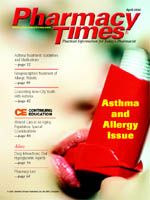Publication
Article
Pharmacy Times
Nonprescription Treatment of Allergic Rhinitis
Author(s):
As many as 40 million Americans are affected with allergic rhinitis (AR), making it the most prevalent chronic respiratory disease. With multiple products available to treat AR without a prescription, pharmacists are in an excellent position to become the primary resource for treating it.
The pathogenesis of AR is triggered by an inflammatory response to an allergen, which results in a complex cascade involving numerous cells and mediators, with histamine being a primary mediator. Symptoms of AR may vary greatly, with some patients presenting with sneezing and rhinorrhea and others simply reporting not feeling well (Table 1). AR can be classified as either seasonal (with repetitive and predictable seasonal symptoms) or perennial (with symptoms that persist throughout the year), depending on the timing and duration of symptoms.
Nonprescription allergy medications relieve and control both seasonal and perennial AR. Treatment goals include symptom reduction and improved quality of life. Drug therapy is symptom- specific and should be initiated utilizing a single drug targeting the dominant symptom. Nonprescription medication options include oral antihistamines, intranasal anticholinergic agents, oral and nasal decongestants, and antihistamine/decongestant combination products (Table 2).
Antihistamines
Oral antihistamines are considered the first-line treatment for the relief of symptoms of AR. They primarily target nasal and ophthalmic itching, sneezing, rhinorrhea, and watery eyes. Antihistamines compete with histamine at central and peripheral histamine1 receptor sites. Antihistamines are classified as sedating (first generation) or nonsedating (second generation). The differences between the types relate to receptor selectivity and the ability to cross the blood-brain barrier. Drowsiness is the most common reported adverse effect and can lead to impaired performance in such activities as driving a car or in functioning at work. The sedative effects vary from class to class, with the nonsedating antihistamines having little to no central nervous system (CNS) effects. The anticholinergic or drying effects of antihistamines can have beneficial therapeutic effects; however, they also cause many adverse effects. Dry mouth, cardiovascular effects, constipation, and difficulty voiding urine are a few.
Antihistamines are more effective when taken prior to exposure to an offending allergen, because they are better at preventing the action of histamine rather than reversing it. Patients should be counseled to take the antihistamine approximately 1 to 2 hours prior to exposure. Patients also should be warned about potential adverse effects, especially drowsiness, and should be counseled against taking other CNS depressants or alcohol.
When choosing an agent, side effects and patient response should be included among the deciding factors. Currently the only nonsedating antihistamine available without a prescription is loratadine. Of the sedating antihistamines available without a prescription, chlorpheniramine, brompheniramine, and phenindamine are the least sedating of the class.
Intranasal Anticholinergic Agents
Cromolyn sodium is indicated for the prevention and treatment of AR. Cromolyn stabilizes mast cells, preventing mediator release; however, the exact mechanism is unknown. The recommended dose is 1 spray in each nostril 3 to 6 times daily at regular intervals. Maximum effects may not be seen for 1 to 2 weeks; therefore, treatment is more effective if started before seasonal symptoms begin. Only about 7% of intranasal chromolyn is absorbed, and what is absorbed has no systemic activity. Sneezing, nasal stinging, and burning are the most common side effects.
Decongestants
Nasal and oral decongestants are used to specifically treat sinus and nasal stuffiness. They are adrenergic agonists that constrict blood vessels throughout the body, reducing blood supply to the nasal and sinusoid vessels and decreasing mucosal edema.
Nasal Agents
Nasal decongestants are applied in spray or drop form directly to the swollen nasal mucosa, with little or no systemic absorption. Side effects are infrequent and usually are the result of local irritation, including burning, sneezing, and nasal dryness.
Nasal decongestants should not be used for more than 3 to 5 days due to rebound nasal congestion (rhinitis medicamentosa). The classic symptom of this condition is continued congestion despite frequent use of the nasal decongestant. Treatment of this condition includes slowly withdrawing the topical decongestant, substituting nasal saline spray, and possibly using oral decongestants or prescription nasal steroids. The mucus membranes often will return to normal within 1 to 2 weeks. Patients should be counseled on the prevention of rhinitis medicamentosa? they should use the product only when absolutely necessary and limit the duration of use to 3 to 5 days.
Oral Agents
Oral decongestants have a slower onset of symptom relief than the nasal decongestants. They have a longerlasting effect, however, and cause less local irritation. Rhinitis medicamentosa often is not a concern with these agents. Nonprescription oral decongestants include pseudoephedrine. Phenylpropanolamine was withdrawn from the market in 2000 because of the increased risk of hemorrhagic stroke. Due to the systemic absorption of the oral decongestants, they are associated with increased side effects. These side effects include insomnia, nervousness, tremors, male urinary retention, and increased blood pressure and heart rate. Children and elderly persons are more likely to experience adverse effects. Patients with hypertension should use decongestants with caution; agents should be used for the shortest length of time possible, and blood pressure must be monitored. There is no clear evidence that any one agent is safer than others for patients with hypertension.
Combination Therapy
Numerous products combine decongestants with antihistamines for the relief of AR. This combination is rational due to the differing mechanisms of action of the drugs. These products are useful for patients who need relief from a multitude of symptoms. They reduce the number of medications the patient must take, potentially enhancing patient compliance.
For a list of suggested reading, send a stamped, self-addressed envelope to: References Department, Attn. D. Ryan, Pharmacy Times, 241 Forsgate Drive, Jamesburg, NJ 08831; or send an e-mail request to: [email protected].

Newsletter
Stay informed on drug updates, treatment guidelines, and pharmacy practice trends—subscribe to Pharmacy Times for weekly clinical insights.






